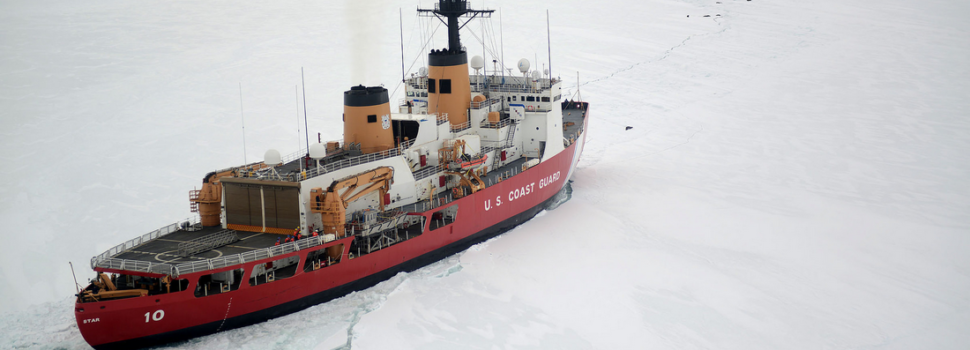
The U.S. Coast Guard is on the cusp of finally acquiring new icebreakers, 42 years after commissioning its only current heavy icebreaker. But politically-motivated maneuvers in the U.S. House of Representatives could scuttle the long-in-works shipbuilding effort.
As of late 2018 the Coast Guard, which has been responsible for the U.S. government’s polar icebreaking mission since 1965, operates just one large icebreaker, the 399-feet-long Polar Star. The service also operates Healy, a 420-feet-long medium icebreaker.
Polar Star can break ice up to 21 feet thick. Healy can muscle through ice no more than four and a half feet thick. Both vessels sail out of Seattle, Washington. In recent years, Healy has spent most of her time in Arctic waters. Polar Star mostly works in the Antarctic. Polar Sea, a sister vessel of Polar Star, has been inactive since 2010.
“Although the Healy is capable of carrying out a wide range of activities, [she] cannot operate independently in the ice conditions in the Antarctic or ensure timely access to some Arctic areas in the winter,” the Government Accountability Office explained in a September 2018 report.
Healy commissioned in 1999. Polar Star, by contrast, is old. She commissioned in 1976. Despite a three-year refit ending in 2012, Polar Staris prone to breakdowns. In early 2018 while on a mission to McMurdo Station, the main base for the U.S. government’s Antarctic research program, Polar Star suffered serious electrical problems.
“We had less ice this year than last year,” U.S. Coast Guard captain Michael Davanzo said in an official press release. But “we had several engineering challenges to overcome to get to the point where we could position ourselves to moor in McMurdo.”
In 2010, the Coast Guard first identified gaps in its ability to conduct missions in the Arctic and Antarctic. Three years later, the Coast Guard formally expressed a need for up to three heavy polar icebreakers and three medium icebreakers. The six ships would “adequately meet these Coast Guard mission demands,” according to the GAO. In light of Polar Star‘s age and unreliability, the Coast Guard told the GAO it wants to acquire the heavy icebreakers first.
In February 2018, the U.S. Congress finally codified the icebreaker requirement in the Department of Homeland Security’s budget for 2019, setting aside $750 million for the first vessel. DHS oversees the Coast Guard during peacetime.
Congress reiterated its support for new icebreakers in the U.S. military’s 2019 budget, which passed into law in August 2018. “It is the sense of Congress that the Coast Guard should maintain an inventory of not fewer than six polar-class icebreaker vessels beginning not later than fiscal year 2029,” the defense authorization act states.
To achieve that inventory, the act states, the Coast Guard should award a contract for the first new icebreaker no later than 2019, deliver the first vessel no later than 2023 and start construction on the second through sixth new ships at a rate of one vessel per year in 2022 through 2026. The Coast Guard should accept delivery of the second through sixth new icebreakers at a rate of one vessel per year in 2025 through 2029.
But no sooner was the ink dry on the defense authorization act than politicians intervened to potentially halt the icebreaker acquisition before it could even begin. Under pressure from supporters of Pres. Donald Trump in the U.S. House, in August 2018 DHS reportedly considered eliminating the $750-million budget line for the lead icebreaker and shifting it into an account for Trump’s controversial, multi-billion-dollar plan to build a wall along the U.S.-Mexican border.
As of September 2018 it’s unclear whether DHS will fund an icebreaker in 2019. If it doesn’t and the Coast Guard must wait at least another year, the United States could lose independent, year-round access to the South Pole.
The Coast Guard told the GAO that Polar Star‘s service life would end as early as 2020. The Coast Guard announced in 2017 a plan to extend the heavy icebreaker’s useful life by at least three years through selective upgrades costing a combined $75 million, starting in 2020.
But the service-extension might prove impractical, or at least cost more than the Coast Guard projected. “The Coast Guard’s $75-million cost estimate for the Polar Star life-extension project may be unrealistic, in part because it was based on the assumption of continuing to use parts from the decommissioned Polar Sea, as has been done in previous maintenance events,” the GAO reported. “Because of the finite number of parts available from the Polar Sea, the Coast Guard may have to acquire new parts for the Polar Star that could increase the $75 million estimate.”
That cost could rise even more if DHS indeed does remove funding for the first icebreaker in the 2019 budget in order to partially fund Trump’s border wall. The longer America’s sole, aged heavy icebreaker sails, the more she breaks down, the more it costs to keep her afloat and the more urgent her replacement becomes.
